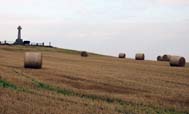The original Short S27 was equipped with a Gnome rotary engine. This replica in the Fleet Air Arm Museum is fitted with a similar Gnome Le Rhone engine and representative propeller to illustrate the appearance of the aircraft in service.*
Early aircraft wings were usually covered with a fabric such as linen. This fabric was painted with a special paint called dope to seal the fabric. If you added too many layers of dope the aircraft would be to heavy to take off!
Both sides in WW1 developed incendiary bullets that would set fire to fabric covered wings. As engines tended to leak oil and fuel and the wings are very flammable this could leave you in the hot seat if you were hit. *
Dashboard & Wicker Seat, Westgate Seaplane Station
These items came from unknown World War 1 aircraft based at the Seaplane Station in Westgate-on-Sea, Kent.
The dials have been removed, but the engravings can still be seen on the dashboard. Once removed from the aircraft the dashboard appears to have been converted for domestic use. The added sections look to have been made to hold stationery!
Seats in WW1 aircraft were made from light and weatherproof material, It is likely the pilot would have had a cushion to sit on. This would have been made of leather and padded with light material, such as horsehair and fabric.*
*information provided next to the exhibit
- More information on the Short S27 can be found here.














Have you been to the Transport Museum in Coventry?
It used to be free.
Yes we have been there.